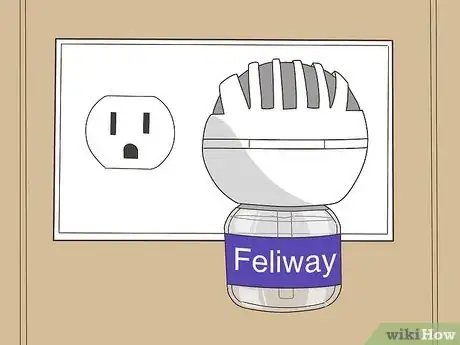This article was co-authored by Pippa Elliott, MRCVS. Dr. Elliott, BVMS, MRCVS is a veterinarian with over 30 years of experience in veterinary surgery and companion animal practice. She graduated from the University of Glasgow in 1987 with a degree in veterinary medicine and surgery. She has worked at the same animal clinic in her hometown for over 20 years.
wikiHow marks an article as reader-approved once it receives enough positive feedback. This article has 13 testimonials from our readers, earning it our reader-approved status.
This article has been viewed 641,448 times.
Most people do not relish the thought of bringing their cats with them on a vacation or on a road trip. There are a few fearless felines that are not finicky about traveling, but for many cats, traveling and leaving their familiar surroundings can be sheer terror. However, it is possible to travel with a cat without a huge amount of problems. The key is to the prepare ahead of time by acclimating your cat to travel gradually and preparing supplies well before the departure date.
Steps
Preparing Ahead of Time
-
1Acclimate your cat to traveling. If your cat hasn’t travelled by car recently, several weeks prior to your trip, take it on several short car rides (30 minutes or less). Be sure to put the cat in the travel cage you will use on your trip to get the cat used to the noise and motion of the car and the smell of the cage.
- Give your cat treats while it is in the car. This will give it better feelings about being there.
- Look upon these as trial runs to work out any kinks before you have to take a long trip far from home.
-
2Get prescription medication for motion sickness, if necessary. If your cat is prone to motion sickness, which your trial runs should determine, ask your vet to prescribe medication. Anti-nausea medication such as chlorpromazine can be used to help control motion sickness.[1]
- The signs of a cat with motion sickness (while in the car of course) include: crying or vocalizing that doesn’t quit after a few minutes into the car ride, excessive drooling, immobility, or acting afraid to move, or excess activity or pacing, vomiting, or urinating or defecating.
- Ginger has also been used to treat nausea in humans and it is safe to use in cats; this can be found in liquid form or chews from on-line or brick and mortar pet stores or in the occasional veterinary clinic.
Advertisement -
3Give your cat the Bach Flower Essence "Rescue Remedy" to help it with the fear and stress of traveling or a fear of new places. Give a few drops in his water each day and a drop in the mouth before setting off each day if he is visibly distressed. You can test its effectiveness by giving an oral dose and then taking a short car ride 30 minutes later. This should be your preferred treatment, as sedatives only slow a cat whereas the flower essence will help them remain calm and confident.
-
4Get prescription tranquilizers as a last resort. Try training with trial drives and non-medicated options first before resorting to medications. Your veterinarian can help you sort out which one will work best for your cat. Some options include over the counter antihistamines (Benadryl) and prescription medication, such as alprazolam (Xanax) to relieve anxiety.[2]
- Discuss dosages with your veterinarian and follow their advice carefully for the best result.
-
5Try any sedatives at home a few days before your trip. Observe the cat's behavior, and if there are any negative results, you still have time to call your vet and adjust dosages or try a different medicine. Just like people, different drugs have different effects on cats. Chances are, if your pet reacts with irritability or something else adverse, your vet will know an alternate treatment to try.
- Most sedatives won't knock the cat out cold and should only take the edge off. If the drug is too sedating or not sedating enough, you should let your vet know before you leave. The cat should remain alert to its surroundings, even when on the sedative.
- While on the medication trial, put the cat in the carrier and take it for a drive. This way, you'll know what behaviors to expect while you're traveling with a medicated cat. Make sure your vet gives you enough medication for the duration of your travel (to and from) and ask for an extra pill or two to try at home before you embark.
-
6Get a towel or blanket and put it in your cat's bed, or wherever it likes to sleep, a few days before the trip. The goal is to get your cat's smells, and the smells of home, onto the towel. In addition, the cat will already be comfortable with the towel and find comfort from it.
-
7Prepare the cage on the morning of the trip, or the night before. Put the towel your cat has been sleeping on at the bottom of the cage, and put an additional towel under the cage if the cage floor needs extra padding. Add a favorite toy to keep your cat company as well.
-
8Spray the inside of the carrier and car with Feliway 20 minutes before you're ready to go. This mimics the pheromones that cats leave when they're comfortable and relaxed in their territory. It should soothe your cat on the ride.[3]
- Be sure to test your cat's reaction to Feliway before spraying it in the carrier. A small minority of cats interpret the spray as another cat's markings and may have a negative or even aggressive reaction to it.
Taking Your Cat on a Trip
-
1Have your cat eat a few hours before traveling and allow it unrestricted access to its litter box. If there is room in the cage you can put a small litter box, but this is not vitally necessary. The same is true of food and water.
- Never make your cat stay in its carrier for longer than eight hours without providing it with food, water and a chance to use the litter box.
-
2Leave the door of the cage open to allow your cat a chance to explore the cage. You want the cat to voluntarily get comfortable going into it. Do not force your cat into the cage if it doesn’t go in at this stage.
-
3Place the cat in the carrier, then carry it to the car. You may want to place a towel or blanket over the carrier when carrying it to the car to block its view of the “scary” outside. Remove it when you place the carrier in the car.
- The carrier should be placed in a secure spot in the car, preferably strapped in place with a seat belt. If the seat belt won’t work, you can use bungee cords or small lengths of rope to secure the carrier in the car in case of sudden stops or an accident.[4]
-
4Place your cat in the carrier with the harness on. Car rides are stressful for cats regardless if they like them or not. Having a harness and a leash on the cat whenever it is out of the carrier (even in the car) gives you something to grab in case the cat decides to bolt from an open window or door.
-
5Allow your cat to stretch its legs. Your cat won't want to go all day in its carrier. This is where the harness and leash come in. Snap the leash on and allow your cat to come out into the car for twenty or so minutes. Offering a chance in the litterbox isn't a bad idea, either, but don't be surprised if your cat turns its nose up at the idea.
-
6Spray wherever you're staying with Feliway (or use the Feliway diffuser) before putting your cat in the room. If you go out, put your cat in its carrier and the 'Do Not Disturb' sign on your door, in case the maid should come by. If you're going to be out for the day, put the cat in the bathroom with its things and shut the door (if possible). Then leave a note on the door stating your cat is currently in there and to please be careful not to let it out.
Expert Q&A
-
QuestionAre cats allowed on airplanes?
 Melissa Nelson, DVM, PhDDr. Nelson is a Veterinarian who specializes in Companion and Large Animal Medicine in Minnesota, where she has over 18 years of experience as a veterinarian in a rural clinic. She received her Doctor of Veterinary Medicine from the University of Minnesota in 1998.
Melissa Nelson, DVM, PhDDr. Nelson is a Veterinarian who specializes in Companion and Large Animal Medicine in Minnesota, where she has over 18 years of experience as a veterinarian in a rural clinic. She received her Doctor of Veterinary Medicine from the University of Minnesota in 1998.
Veterinarian Yes, cats are allowed on airplanes generally, but you must always check with the airline for their requirements. Also, make sure your cat is healthy and in good shape to fly.
Yes, cats are allowed on airplanes generally, but you must always check with the airline for their requirements. Also, make sure your cat is healthy and in good shape to fly. -
QuestionHow long can a cat hold their urine?
 Melissa Nelson, DVM, PhDDr. Nelson is a Veterinarian who specializes in Companion and Large Animal Medicine in Minnesota, where she has over 18 years of experience as a veterinarian in a rural clinic. She received her Doctor of Veterinary Medicine from the University of Minnesota in 1998.
Melissa Nelson, DVM, PhDDr. Nelson is a Veterinarian who specializes in Companion and Large Animal Medicine in Minnesota, where she has over 18 years of experience as a veterinarian in a rural clinic. She received her Doctor of Veterinary Medicine from the University of Minnesota in 1998.
Veterinarian Cats can hold their urine for at least 12 hours, often even longer. This should not be the norm however, as infrequent urination can be a sign of underlying health issues.
Cats can hold their urine for at least 12 hours, often even longer. This should not be the norm however, as infrequent urination can be a sign of underlying health issues. -
QuestionCan you leave a cat alone?
 Melissa Nelson, DVM, PhDDr. Nelson is a Veterinarian who specializes in Companion and Large Animal Medicine in Minnesota, where she has over 18 years of experience as a veterinarian in a rural clinic. She received her Doctor of Veterinary Medicine from the University of Minnesota in 1998.
Melissa Nelson, DVM, PhDDr. Nelson is a Veterinarian who specializes in Companion and Large Animal Medicine in Minnesota, where she has over 18 years of experience as a veterinarian in a rural clinic. She received her Doctor of Veterinary Medicine from the University of Minnesota in 1998.
Veterinarian Yes, you can leave a cat alone for short periods of time - less than 2-3 days, as long as they have access to food, water, safe shelter and a littler box.
Yes, you can leave a cat alone for short periods of time - less than 2-3 days, as long as they have access to food, water, safe shelter and a littler box.
Warnings
- Make sure your cat is wearing the collar and ID tags at all times! You never know if your cat will somehow weasel its way away. A microchip with up to date information on record with the chip company is a never-loose ID tag. A rescuer will need to have a vet or shelter scan it to get the number.⧼thumbs_response⧽
- Do not allow a cat unrestricted access to your car when you're driving. Even the smallest things can spook a cat, and the last thing you need is a cat hiding in the back of your car, under the seat where you can't reach it, or dashing under your feet to the pedals. If you're riding with passengers and your cat likes to look out the window, putting a harness and leash on and allowing the cat to sit that way may not be a bad idea. Be careful your cat does not become agitated about it, however.⧼thumbs_response⧽
- Never leave your cat in the car alone, even with the windows cracked. It can take less than twenty minutes for your pet to overheat and die when left in a car.⧼thumbs_response⧽
Things You'll Need
- Litterbox
- Food and water dishes
- Cat carrier
- Small towel or blanket
- Scratching post or pad
- Food
- Water
- Cat toys, string
- Cat harness and leash
- Cat collar with ID tags
- Feliway
- Enzyme based cleaner in case your cat has an accident in the car or hotel.
- Rescue Remedy spray
- Medications
References
- ↑ http://www.petmd.com/cat/conditions/digestive/c_ct_motion_sickness?page=2
- ↑ http://www.vcahospitals.com/main/pet-health-information/article/animal-health/motion-sickness-in-cats/6528
- ↑ http://www.feliway.com/uk/What-causes-cat-stress-or-anxiety/Traveling-with-a-cat-in-a-cat-carrier
- ↑ http://www.vcahospitals.com/main/pet-health-information/article/animal-health/motion-sickness-in-cats/6528
About This Article
To prepare your cat for travel, make sure your cat eats and drinks several hours before traveling and has access to the litter box until it's time to go so it doesn't need to go on the road. Right before putting your cat in its crate, place a harness on it so you can easily leash your cat when you open the crate. Plan to let your cat out to stretch its legs every few hours, and use the leash to keep your cat from running away! For more tips from our Veterinarian reviewer, including how to use pheromones to keep your cat calm, keep reading!














-Step-11-Version-6.webp)


















-Step-11-Version-6.webp)





































